Increased Data Quality
ERP & MES Integration
Industry 4.0 Ready
Case Study
Enterprise Production Asset Management
A global manufacturer of ready to assemble home furnishings, operating more than 20 factories, needed to improve the management of its production assets, including buildings, machines, work centres, IoT sensors and network topology.
Managing IoT sensor data was a particular challenge, as each sensor required a unique identifier and consistent, well structured information to integrate with other systems.
What was the goal?
Building a Future-Ready Asset Data Foundation
The objective was to ensure the organisation was data ready for Industry 4.0 by improving data quality, establishing robust data connections, and strengthening cyber security.
Additional goals included enabling CO₂ emission tracking and supporting emerging capabilities such as agentic AI.
What was getting in the way?
Fragmented Data & Limited Scalability
Data was stored in multiple inconsistent Excel sheets and structured differently across sources, making consolidation difficult. Core production and enterprise systems used inconsistent data and semantic definitions, causing misalignment.
Multiple inconsistent Excel sheets holding data and structures.
Inconsistent data and semantic definitions in MES and ERP systems.
Preventative maintenance tests were not scalable across factories.
Uncertainty about how to proceed stalled progress.
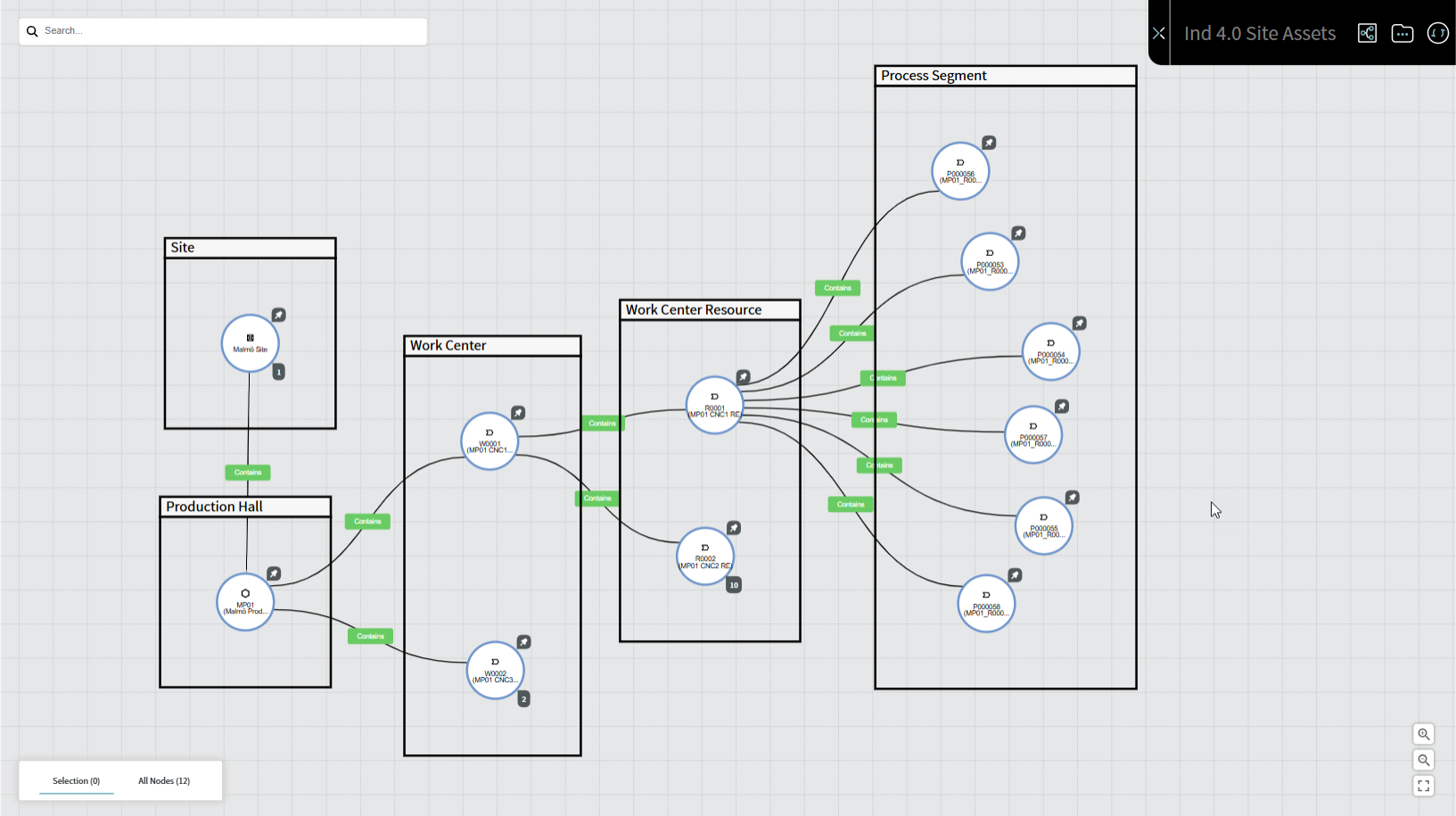
By help of inorigo’s® Model Explorer, it was easy to verify data samples and how they were related, which supported clear communication between subject matter experts and the modelling team.
How was it addressed?
Collaborative Modelling & Rapid Implementation
Modelling workshops with subject matter experts were held to design a flexible model covering sites, production centres, IoT devices, tags, DNS, and heat.
The model was implemented and tested with real data, gaining acceptance from stakeholders. A governance structure was established, and the proof of concept was moved into production within a few months.
What was the result?
A Governed, Scalable Asset Management Framework
The project delivered a scalable asset management structure that connected IoT device metrics with energy consumption data, laying the foundation for AI services, preventative maintenance, and precise analysis.
Asset governance application was created to govern IoT assets and their tags, with all data verified against model constraints and rules to prevent inconsistencies and duplicates.
Tag names were automatically generated through ordered rules, guaranteeing uniqueness and simplifying data management.
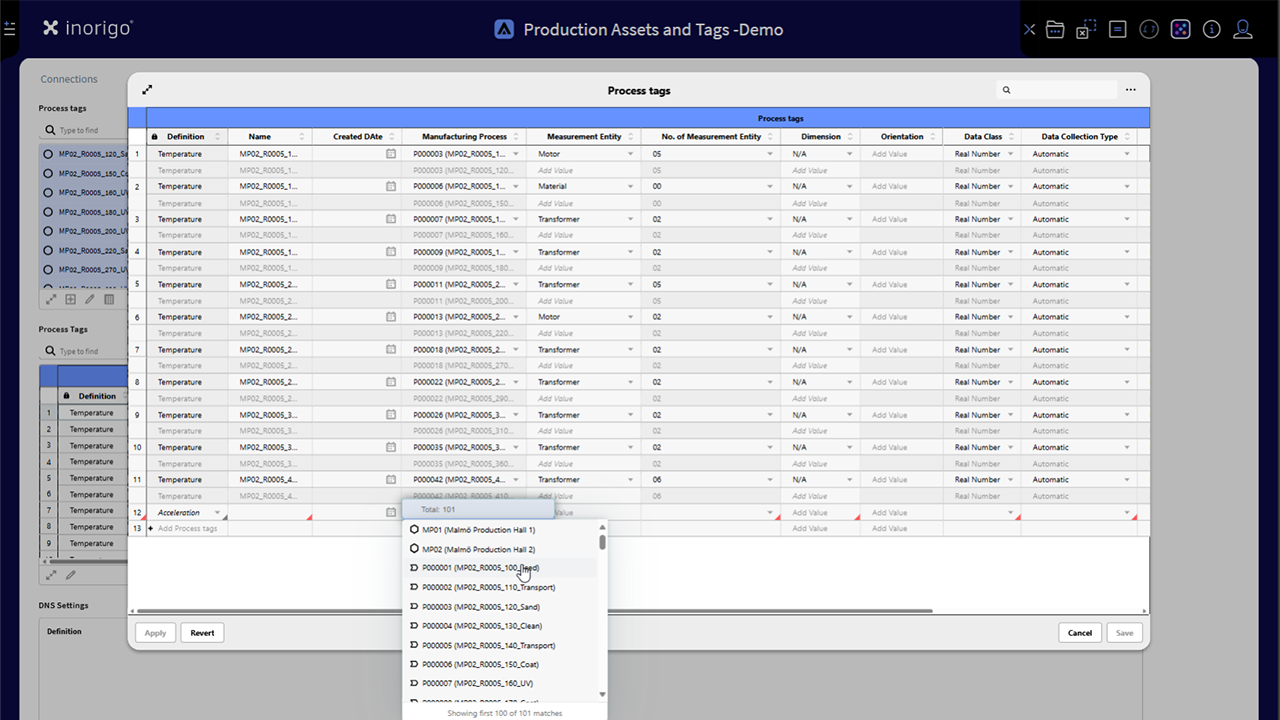
Sample inorigo® application that Governs IoT Assets and their TAGs. User group–based authorisation ensures that each user can govern only the data for their own factory.
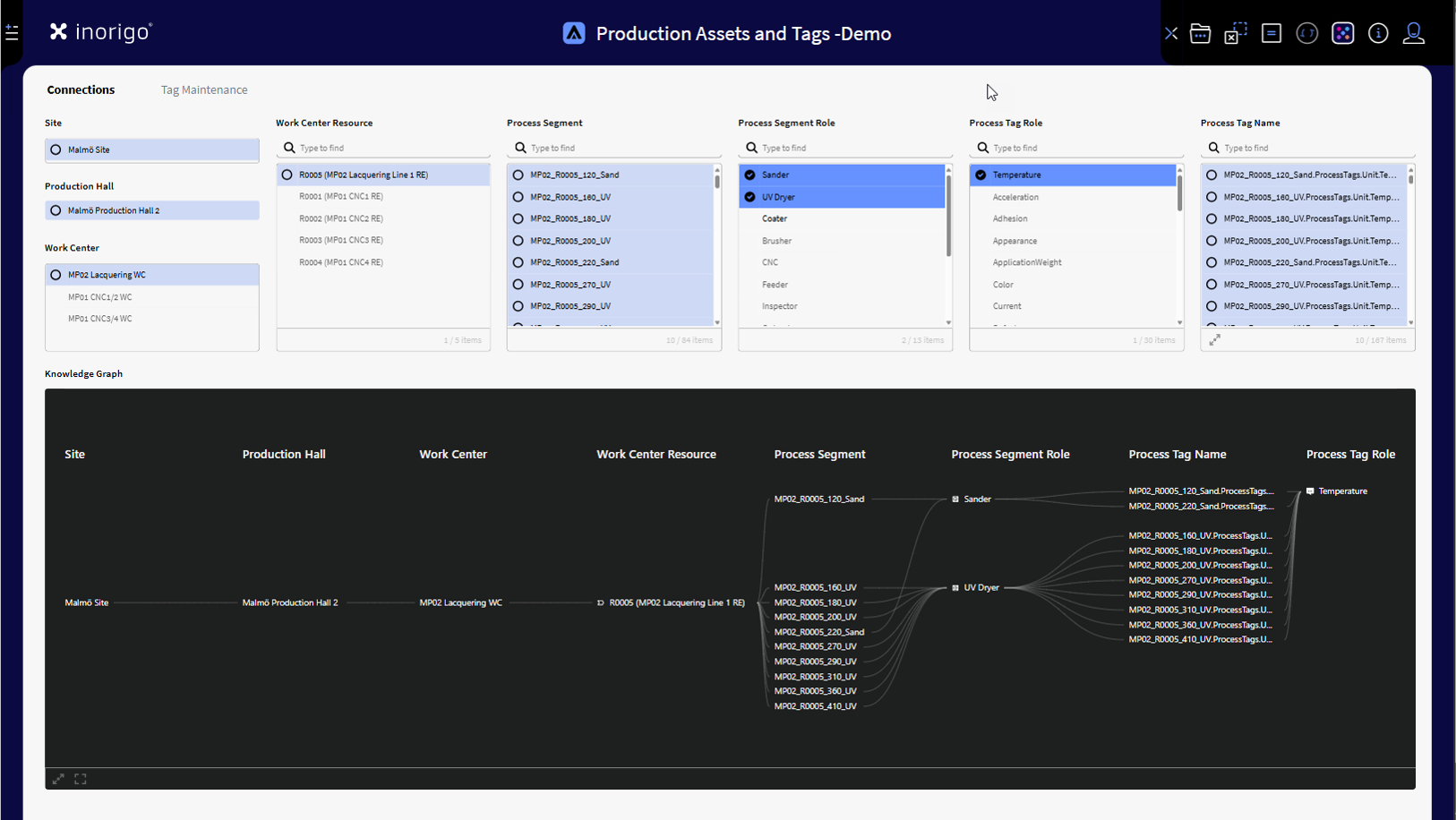
An example of an inorigo® Application that provides an overview of the production assets, and how they relate to each other.
What was the impact?
Factory-Level Readiness for Industry 4.0
The solution was rolled out gradually, reducing big bang risks, and has already seen successful launches across multiple markets with positive feedback.
A flexible data model for each factory
A solid governance structure.
Increased data quality.
Integrations with streaming services, ERP, and MES systems.
Unique tag naming with improved streaming analysis.
Questions about this case or a related challenge?
Reach out anytime — we’ll gladly share more details or discuss how we can assist.

DANIEL LUNDIN
Managing Director
+46 (0)70 921 27 05
daniel.lundin[@]inorigo.com
Connect with me on LinkedIn
More Case Studies
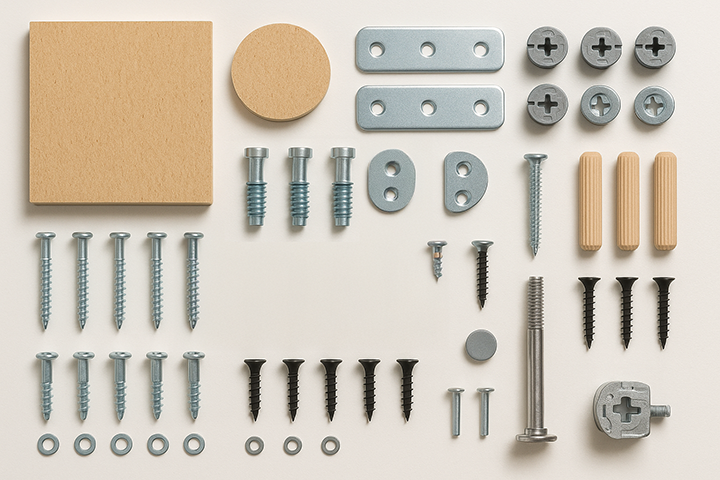
Spare Parts Management
Our partner’s client, a retailer of ready-to-assemble home furnishings, needed help improving the way they manage and distribute spare parts to support product longevity and customer satisfaction…
READ MORE
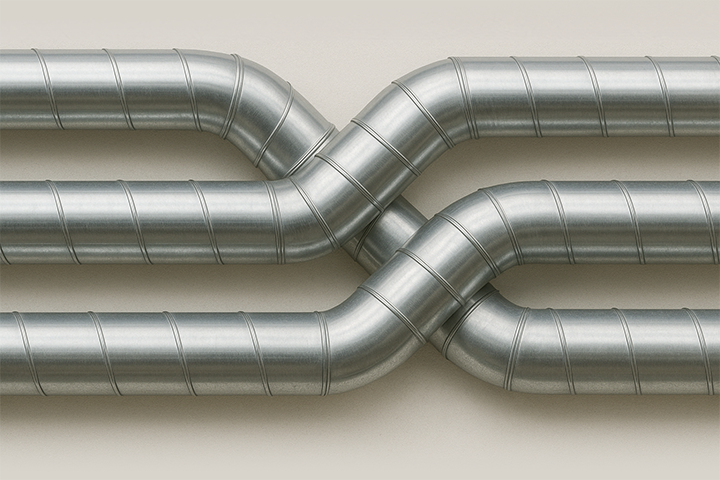
Boosting AI Accuracy With Structured Product Taxonomy
When developing an AI-powered field assistant for service technicians, a client found that training solely on the product catalogue’s text data did not meet precision needs…
READ MORE

Harmonized Chemical Data Across Systems
Our client, a multinational pharmaceutical company needed help improving how they manage and align chemical master data…
READ MORE
Data Quality
ERP & MES Integration
Industry 4.0
Case Study
Enterprise Production Asset Management
A global manufacturer of ready to assemble home furnishings, operating more than 20 factories, needed to improve the management of its production assets, including buildings, machines, work centres, IoT sensors and network topology.
Managing IoT sensor data was a particular challenge, as each sensor required a unique identifier and consistent, well structured information to integrate with other systems.
What was the goal?
Building A Future-Ready Asset Data Foundation
The objective was to ensure the organisation was data ready for Industry 4.0 by improving data quality, establishing robust data connections, and strengthening cyber security.
Additional goals included enabling CO₂ emission tracking and supporting emerging capabilities such as agentic AI.
What was getting in the way?
Fragmented Data & Limited Scalability
Data was stored in multiple inconsistent Excel sheets and structured differently across sources, making consolidation difficult. Core production and enterprise systems used inconsistent data and semantic definitions, causing misalignment.
Multiple inconsistent Excel sheets holding data and structures.
Inconsistent data and semantic definitions in MES and ERP systems.
Preventative maintenance tests were not scalable across factories.
Uncertainty about how to proceed stalled progress.
How was it addressed?
Collaborative Modelling & Rapid Implementation
Modelling workshops with subject matter experts were held to design a flexible model covering sites, production centres, IoT devices, tags, DNS, and heat.
The model was implemented and tested with real data, gaining acceptance from stakeholders. A governance structure was established, and the proof of concept was moved into production within a few months.

By help of inorigo’s® Model Explorer, it was easy to verify data samples and how they were related, which supported clear communication between subject matter experts and the modelling team.
What was the result?
A Governed, Scalable Asset Management Framework
The project delivered a scalable asset management structure that connected IoT device metrics with energy consumption data, laying the foundation for AI services, preventative maintenance, and precise analysis.
Asset governance application was created to govern IoT assets and their tags, with all data verified against model constraints and rules to prevent inconsistencies and duplicates.
Tag names were automatically generated through ordered rules, guaranteeing uniqueness and simplifying data management.

Sample inorigo® application that Governs IoT Assets and their TAGs. User group–based authorisation ensures that each user can govern only the data for their own factory.
What was the impact?
Factory-Level Readiness For Industry 4.0
The solution was rolled out gradually, reducing big bang risks, and has already seen successful launches across multiple markets with positive feedback.
A flexible data model for each factory.
A solid governance structure.
Increased data quality.
Integrations with streaming services, ERP, and MES systems.
Unique tag naming with improved streaming analysis.
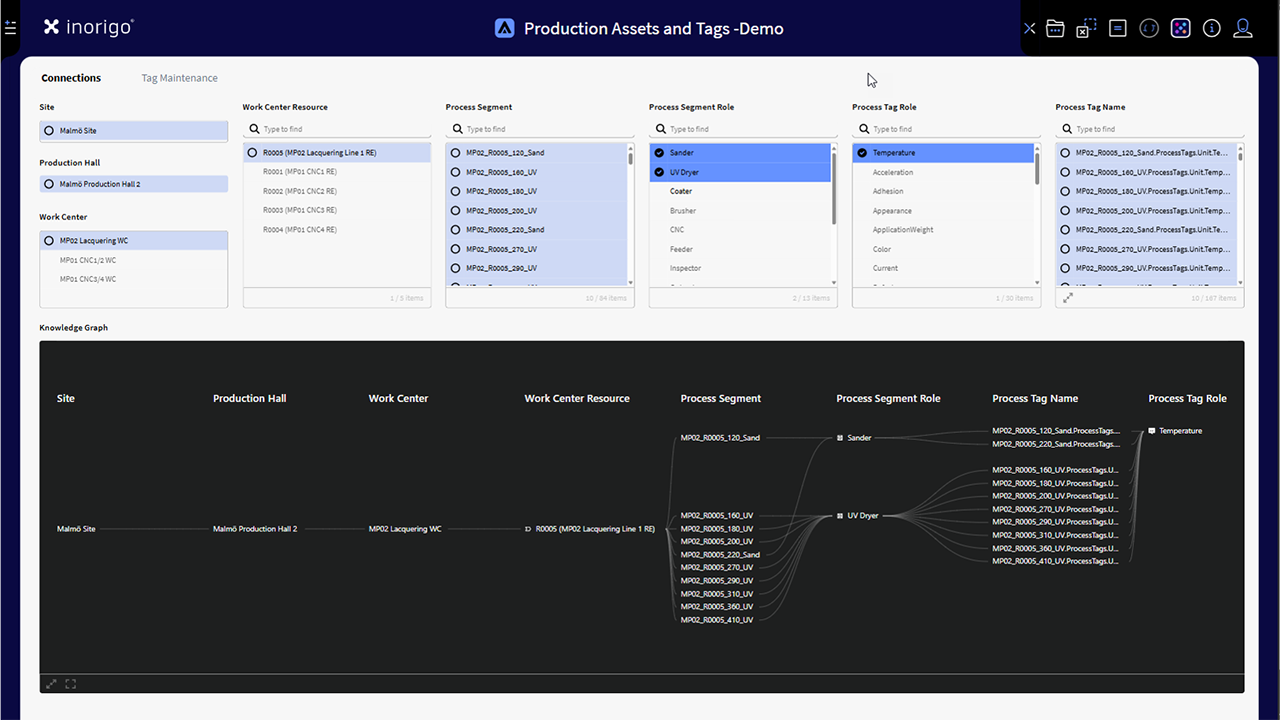
An example of an inorigo® Application that provides an overview of the production assets, and how they relate to each other.
Questions about this case or a related challenge?
Reach out anytime — we’ll gladly share more details or discuss how we can assist.

DANIEL LUNDIN
Managing Director
+46 (0)70 921 27 05
daniel.lundin[@]inorigo.com
Connect with me on LinkedIn
More Case Studies

Spare Part Management
Our partner’s client, a retailer of ready-to-assemble home furnishings, needed help improving the way they manage and distribute spare parts to support product longevity and customer satisfaction…
READ MORE

Boosting AI Accuracy With Structured Product Taxonomy
When developing an AI-powered field assistant for service technicians, a client found that training solely on the product catalogue’s text data did not meet precision needs…
READ MORE

Harmonized Chemical Data Across Systems
Our client, a multinational pharmaceutical company needed help improving how they manage and align chemical master data…